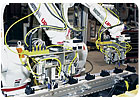Although daunting, the FDA regulations governing medical device assembly make good manufacturing sense.

Although rigorous, the FDA regulations governing the design and production of medical devices are there for a good reason-to protect the public by ensuring good manufacturing practices. Photo courtesy Gen-Probe Inc.
In fact, in the case of medical device design and manufacture, the regulations put in place by theFood and Drug Administration(Rockville, MD) simply reflect good engineering practices. By embracing the spirit of these rules, as opposed to just regarding them as a series of obstacles, medical device manufacturers can actually improve the efficiency of their design and assembly processes-as well as save themselves a world of potential headaches.

Engineers need to remember that if their assembly processes are not FDA compliant their products will be judged as unacceptable as well, even if there is nothing actually wrong with them. Photo courtesy Motoman Inc.
The Way We Were
An offshoot of the Federal Division of Chemistry (which earned its keep exposing the various phony and adulterated medical products that proliferated in the late 19th century) the modern FDA came into being in 1906, with passage of the Federal Food and Drugs Act. For decades, the Food, Drug and Insecticide Administration, as it was originally known, fell under the control of the Department of Agriculture. Today, the FDA is a part of the Department of Health and Human Services (Washington).Although the organization originally focused on the labeling of drugs, it soon began regulating the drugs themselves. With passage of the 1938 Food, Drug and Cosmetic Act, the FDA also took over jurisdiction of medical devices from the Federal Trade Commission. However, it was not until 1976, with passage of a number of Medical Device Amendments, that the FDA really went into medical device regulation in a big way.
These amendments-which came in the wake of the Dalkon Shield intrauterine device controversy, in which a contraceptive device was found to have caused thousands of injuries and a few dozen deaths-created three separate classes of medical devices based on the potential harm they can cause patients. Class I includes fairly benign pieces of equipment, like bedpans and tongue depressors. Class II includes potentially more dangerous items, like X-ray machines, some surgical instruments and acupuncture needles. Class III includes devices whose malfunction can result in severe injury or even death, such as heart valves and implantable pacemakers.
Complementing these classifications are a number of different approval levels. Exempt products-generally those in Class I-are subject to fairly simple “general” controls, which ensure they function as intended. At the other end of the spectrum, all new Class III devices require formal premarket approval (PMA) before they can be brought to market. Between these two extremes fall thousands of Class II devices that simply build on an existing therapy-say, a new and improved hypodermic needle. These kinds of products, which are said to be based on pre-approved, “substantially equivalent” technology, require 510(k) approval.
In addition, in recent years the FDA has also begun including design controls in its good manufacturing and quality standards. This effort stems in large part from the growing use of digital technology and the functional problems that can result when programming is not executed correctly-a danger that was made all too evident when a Canadian-built linear accelerator used in the treatment of cancer began burning patients because of a software glitch. The result has been the FDA’s Quality System Regulation (QSR), created in the late 1990s.
Note that when thinking about these various classifications and approvals, it is important to remember that PMA or 510(k) approval and QSR refer to two very different things. Specifically, PMA and 510(k) premarket notifications and approvals allow the FDA to examine a device’s safety and efficacy, in other words a device’s ability to do what it is intended to do without causing harm. The FDA’s QSR requirements, on the other hand, regulate the processes that a manufacturer uses to design and manufacture a particular device. That way the FDA can be sure it will function as intended out in the field.
With this in mind, production engineers need to pay particular attention to the FDA’s 21 CFR Part 820.70 quality system regulations. It is this section that governs the production and process controls that comprise the FDA’s Current Good Manufacturing Practices (cGMP). Specific requirements include documented work instructions, standard operating procedures, and monitoring and control of process parameters and device characteristics during production. Section 820.75 addresses formal process validation. Section 820.72 addresses inspection, measuring and test equipment. Section 820.30 regulates the design, development and implementation of medical devices.
Ultimately, in the words of the FDA, the goal of these regulations is to make sure each manufacturer, “Shall develop, conduct, control and monitor production processes to ensure that a device conforms to its specifications.”
Similarly, with respect to test and inspection, the FDA wants to be certain that all manufacturers, “Shall ensure that all inspection, measuring and test equipment, including mechanical, automated or electronic inspection and test equipment, is suitable for its intended purposes and is capable of producing valid results. Each manufacturer shall establish and maintain procedures to ensure that equipment is routinely calibrated, inspected, checked and maintained.”
Walking the Walk
Fair enough. The question, then, becomes how a manufacturer will address these various edicts and standards. Basically, engineers have two choices. They can regard the FDA’s requirements as just another obstacle to their creativity. Or they can embrace the spirit of the regulations, making sure they are both implementing and documenting FDA methods and protocols from the outset-thereby providing better control of the design process.Obviously, taking the latter approach can make life much easier when it comes time undergo an FDA audit. If your records are already in order, there’s no need for any last-minute flurry of activity to retroactively make sure your company is compliant.
Even more important, though, is the fact that by following FDA guidelines, a company stands a much better chance of catching manufacturing or design errors early on. This can actually make bringing a new product to market more efficient in the long run, since fewer problems at the tail end of new-product development mean a healthier bottom line.
“The regulations really do make a lot of sense,” says Alan Schwartz, executive vice president ofmdi Consultants Inc.(Great Neck, NY), a consulting firm that specializes in helping companies bring new medical devices to market as well as ensure that their quality systems are in compliance. According to Schwartz, the regulations may appear “unforgiving,” but they are also very effective at catching production or product failures before a device is shipped.
David Vogel, president of the medical consulting firmIntertech Engineering Associates Inc.(Norwood, MA), agrees.
“The people who complain the most about the FDA being over-hard, generally are the people who aren’t doing things right in the first place,” Vogel says. “These aren’t things the FDA just dreamed up in Rockville…. There’s nothing in the regulations asking you to do useless things.”
According to Schwartz, smaller companies, and startups in particular, need to be on their guard against cutting corners in terms of compliance. Obviously, with fewer resources on hand and often being new to the medical industry, they are at greater risk of missing something that will come back to haunt them during an FDA visit.
However, Vogel warns that even larger companies need to make a conscious effort to remain vigilant, especially if there has been substantial turnover or a change in ownership.
“You can have a company with great procedures in place, then 5 years later only a third of the team remains,” Vogel says. “Everybody thinks they’re doing a good thing by trying to get the product out faster, but that’s not always the case.”
Both Vogel and Schwartz emphasize that manufacturers and OEMs need to be especially careful not to neglect the QSR components of their compliance-in other words, their manufacturing and quality processes-just because the product itself has been approved.
In many cases, new players in the medical field assume that product approval means their work is done in terms of compliance. However, nothing could be further from the truth. Just because the FDA may not get around to auditing a company’s manufacturing facilities until well after a new device has gone into production, that doesn’t mean a company can let its guard down. Failure to comply with FDA quality, design and process standards can result in warning letters, reprimands and product recalls, even if the product itself is working flawlessly.
Vogel compares the situation to that faced by aerospace companies. Just because the Federal Aviation Administration signs off on a particular aircraft design, that doesn’t mean Cessna or Boeing can slap the thing together any way they please. The FAA also has to sign off on their manufacturing processes if they want to be able to bring their products to market.
“Working well has nothing to do with compliance,” Schwartz says, summing up the FDA’s dedication to safe, reliable manufacturing.
Schwartz adds that paying attention to processes is just as important for OEMs that outsource actual production to a contract manufacturer as it is for companies that build their medical devices in-house. Newcomers to the field may assume an “FDA approved” manufacturer will be responsible for all process requirements. However, in recent years the FDA has been very specific that the OEM, or “Specifications Developer,” has ultimate responsibility for making sure a device is manufactured correctly.
Again, engineers and managers who think their regulatory obligations have been satisfied just because a device itself has PMA or 510(k) approval may be putting themselves at risk.
“The FDA expects that the spec developer will make sure the contract manufacturer is QSR-cGMP compliant,” Schwartz says. “Handing over manufacturing operations to another company doesn’t let the OEM off the hook for assuming compliance.”
Editor’s Note: ASSEMBLY magazine would like to thank Intertech Engineering Associates Inc. and mdi Consultants Inc. for their help researching this article.